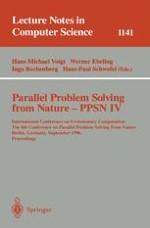1996 | ReviewPaper | Buchkapitel
Modeling urban growth by cellular automata
verfasst von : Thomas Bäck, Holger Dörnemann, Ulrich Hammel, Pierre Frankhauser
Erschienen in: Parallel Problem Solving from Nature — PPSN IV
Verlag: Springer Berlin Heidelberg
Enthalten in: Professional Book Archive
Aktivieren Sie unsere intelligente Suche, um passende Fachinhalte oder Patente zu finden.
Wählen Sie Textabschnitte aus um mit Künstlicher Intelligenz passenden Patente zu finden. powered by
Markieren Sie Textabschnitte, um KI-gestützt weitere passende Inhalte zu finden. powered by
The structural development of human settlements can be characterized as a complex highly feedbacketed process. The assumption that this process is governed by rather few fundamental laws stimulated a considerable research in the field of urban growth during the last decade. Aiming at the comprehension of the basic underlying dynamics different approaches from the field of self-organizing systems have been proposed. In this paper we present a “cellular model” of urban growth dynamics based on the work of White, Engelen and Uljee. As a starting point this model throws some light on the mechanism of urban growth. But even more important, it raises a lot of questions concerning the requirements for a sound modeling technique. One of these questions is how to assess the complex patterns produced by single simulation runs. Here we make especially use of fractal measures reducing the contained information to a manageable size. No doubt, this field of research is still in its infant state, and we are far from being able to hand a reliable tool to the decision maker. But promising results will stimulate future investigations which we hope will lead to a deeper insight into the nature of cities to improve the living conditions of their inhabitants.
